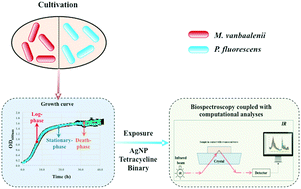Spectrochemical analyses of growth phase-related bacterial responses to low (environmentally-relevant) concentrations of tetracycline and nanoparticulate silver†
Abstract
Exposure to environmental insults generally occurs at low levels, making it challenging to measure bacterial responses to such interactions. Additionally, microbial behaviour and phenotype varies in differing bacterial types or growth phases, likely giving rise to growth- or species-specific responses to environmental stimuli. The present study applied a spectrochemical tool, infrared (IR) spectral interrogation coupled with multivariate analysis, to investigate the growth- and species-specific responses of two bacterial strains, Gram-negative Pseudomonas fluorescens and Gram-positive Mycobacterium vanbaalenii, to low concentrations of tetracycline, nanoparticulate silver (AgNP) or mixtures thereof. Results indicate the tendency for tetracycline-induced biospectral alterations to occur in outer-cellular components, e.g., phospholipids or proteins, while AgNPs-induced changes are mainly associated with proteins (∼964 cm−1, ∼1485 cm−1, ∼1550 cm−1, ∼1650 cm−1). The primary altered targets are correlated with bacterial membranes or outer-cellular components. Furthermore, significant lipid changes at 1705–1750 cm−1 were only present in P. fluorescens cells compared to M. vanbaalenii, owing to differences in cell wall structure between Gram-positive and -negative bacteria. This study also found distinct biospectral alterations in non-log phase compared to log phase, confirming bacterial growth-dependent responses to environmental exposures. It implies that previous studies on log phase only may underestimate the impacts from exposures of interest in situ, where bacteria stay in different growth stages. Our work proves the feasibility of biospectroscopy in determining bacterial responses to low-level environmental exposures in a fast and efficient manner, revealing sufficient biochemical information continuously through growth phases. As a nondestructive approach, biospectroscopy may provide deeper insights into the actual and in situ interactions between microbes and environmental stimuli, regardless of the exposure level, growth phase, or bacterial types.



 Please wait while we load your content...
Please wait while we load your content...